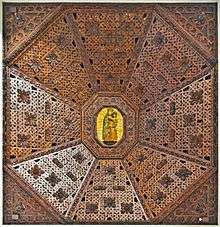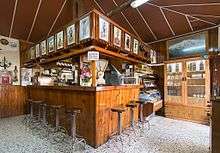La Orotava
Understand
Located in the fertile Orotava Valley uphill from Puerto de la Cruz, La Orotava (from Guanche: Arautaba) was formally established in 1504 by the Spanish following their conquest of Tenerife. As the area was blessed with a mild climate, many Spanish elite chose to settle here; most of the city's historic buildings from this early period have been preserved and now now fall under landmark protection.
The municipal boundaries of La Orotava encompass most of Teide National Park, making it the largest municipality in Tenerife. It can be a good base for hiking, with many trail heads located just outside the city and easily accessible by bus.
- 🌍
Información Turística (Tourist Information), C/ Calvario, 4, ☎ +34 922 323 041, fax: +34 922 334 512. M-F 08:00-18:00. Has information about various sights in Orotava as well as elsewhere on the island.
- 🌍 Información Turística (Tourist Information). Tu-Th 09:00-11:00 11:20-14:00. A smaller tourist booth.
Get in
By car
La Laguna lies just south of the TF-5 expressway, 26km from La Laguna and 35km from Santa Cruz. Parking spots in the city centre are very scarce, and day-trippers will likely find it much easier to visit the city by bus.
By bus
- 🌍 Estación de Autobuses (Estación de Guaguas / Bus Station), C/ San Juan Bosco, s/n, ☎ +34 922 332 702. Information centre: M-F 06:00-12:30 13:30-20:30, Sa Su and holidays 06:00-10:15 13:00-15:00. From Puerto de la Cruz, bus 345 runs daily 05:40-21:55 (€1.45, 20 min, leaves every ½ hr). From La Laguna, bus 101 runs 06:00-21:00 (€3.15, 54 min, leaves every ½ hr). From Santa Cruz, bus 108 is the most direct, running 06:15-22:15 (€4.30, 53 min, leaves every 1-2 hrs).
Get around
If you're reasonably fit and able to walk up and down steep streets, most sights can be easily visited by foot. Otherwise, the long-distance Titsa buses are used as the local bus service. See above for bus details.
See


- 🌍
Plaza de la Constitución (Plaza del Kiosco) (above C/ Calvario). The pleasant square with a café is a good viewing platform, with good views as far as Puerto de la Cruz.
- 🌍 Iglesía de San Agustín (Church of St. Augustine) (NE corner of the plaza). The 17th-century church was once part of a former monastery which is now used as a music school. Especially noteworthy are its bell tower, built of black volcanic stone, and the elaborate Mudejar-style carved wooden ceiling.
- 🌍 Liceo de Taoro, C/ San Agustín, 6 (SE corner of the plaza). Built in 1925 as a private mansion, the building is now used for a school and also houses a café. The garden in front is freely open to passersby.
- 🌍 Jardines del Marquesado de la Quinta Roja (Jardines Victoria). Once belonging to the mansion of the Marquis de la Quinta Roja, the terraced 19th-century gardens were acquired by the city in 1991 and opened to the public. The structure located on the uppermost terrace was initially conceived as a mausoleum, but never used. Free.
- 🌍 Hijuela del Botánico (Hijuela Botanical Garden). M-F 09:00-14:00. Located on the grounds of a former convent, this lovely garden established in 1788 as a nursery for the larger Jardín Botánico in nearby Puerto de la Cruz. It has tropical plants from several continents, as well as an especially large drago tree. Free.
- 🌍 Plaza del Ayuntamiento. Facing the 19th-century neoclassical town hall, the square is the focal point of annual festivities including Carnival, Corpus Christi, and Christmas.
- 🌍 Iglesia de la Concepción (Church of the Immaculate Conception). Considered to be the finest example of Spanish Baroque in the Canary Islands, the current structure was built between 1768 and 1788 on the site of several earlier structures, the earliest dating to the late 15th century. The sculpture in the plaza in front of the church represents an alfombrista, an artist responsible for the volcanic sand 'carpets' created during Corpus Christi celebrations.
- 🌍 Casa Lercaro (Casa Ponte Fonte). Built in 1654, facade has beautifully carved balconies and windows, and there is a lovely interior courtyard as well as a café.
- 🌍 Casa de los Balcones (Casa Mendez-Fonseca), C/ San Francisco, 3, ☎ +34 922 330 629, e-mail: casadelosbalcones@casa-balcones.com. Daily 08:30-19:30. The three-story house was built in the 16th century and is noteworthy for its carved wooden balconies, not only those on the outer facade but especially those inside the courtyard which are also decorated with subtropical hanging plants. The house functions as a museum, and still has its original furniture as well as a wooden wine press in the back of the courtyard. There is also a large souvenir shop on the ground floor which has a especially good selection of traditional embroidery. Free.
- 🌍 Museo de Las Alfombras (Casa Jimenez Franchi), C/ San Francisco, 5. M-F 11:00-13:00. Built in 1592, the museum has exhibits illustrating the tradition of alfombras, volcanic sand 'carpets' used in the Corpus Christi celebrations.
- 🌍 Museo de Artesanía Iberoamerica (MAIT / Museum of Iberian-American Handcrafts), C/ Tomás Zerolo, 34 (next to the Iglesia de Santo Domingo), ☎ +34 922 328 160, e-mail: mait@tenerife.es. M-F 10:00-15:00. Located in a former 17th-century convent, the museum is devoted to the exhibition of arts and crafts from the Canary Islands, as well as from Latin America and the Philippines. The building itself is worth seeing in its own right. €2.50 (adults), free (children).
- 🌍 Mirador de Humboldt (Humboldt's Viewpoint), TF-21 Expressway. Named after the Prussian naturalist Alexander von Humboldt, the view today encompasses many more buildings than it did in his day when he passed through the valley and admired it in 1799. It's unclear whether this exact spot is the same visited by Humboldt (there is also a restaurant and another parking spot with the same name); from both spots however there are fantastic views from La Orotava to Puerto de la Cruz, and on clear days the peak of Teide is also visible. Take a moment too to look in the other direction – on the upper part of the mountain is the 🌍 Cueva de Bencomo, where it is believed the Guanche king Bencomo once lived.
Do


- Festividad del Corpus Christi (Feast of Corpus Christi). 60 days after Easter, usually late May or early June. The Catholic Feast of Corpus Christi has been celebrated in the Canaries since the arrival of the Spanish in the 15th century. As in some other nearby parishes, street processions take place atop elaborate flower 'carpets' (alfombras), laid out the day before by neighbourhood groups, in a tradition practiced since the mid-19th century. Unique to La Orotava is the giant volcanic sand 'carpet' in the Plaza del Ayuntamiento. This tradition dates to 1912, and its creation requires several weeks; visitors can observe the process from the upper steps of the plaza.
- Hiking. Given that Teide National Park extends right up to the edge of the city, Orotava is a good starting point for a number of hikes of varying length and difficulty, a few of which can be accessed by public bus. The Tenerife tourism board maintains a list of nearby hiking trails with descriptions here.
Buy
- 🌍 Casa del Turista (Casa Molina), C/ San Francisco, 4, ☎ +34 922 330 629 x216. Daily 09:00-06:30. Housed in a former 16th-century convent, the shop sells embroidered textiles along with ceramics and Canarian cigars. It also has a permanent exhibit with mannequins dressed in traditional costumes as well as a room displaying the technique of producing the volcanic sand 'carpets' used in the Corpus Christi celebrations.
Eat

- 🌍 Bar Restaurante La Duquesa, Plaza Patricio García, 6B, ☎ +34 922 334 949. M-F 07:00-16:00, Sa 08:30-15:00. A very popular family-run restaurant which serves traditional Canarian dishes. There is outdoor seating in the plaza as well as indoors. Set menu €8.50.
- 🌍 Restaurante Sabor Canario, C/ Carrera del Escultor Estévez, 17, ☎ +34 922 322 793, e-mail: info@saborcanario.es. M-Sa 12:00-22:00. Located in the courtyard of a hotel, this highly-regarded restaurant serves modern variations of traditional Canarian dishes. Set menu €13-15.
Drink
Vineyards were first established in the Orotava Valley with the arrival of the Spanish in the 15th century, and both red and white wines produced here are specially designated by the Spanish Denominación de Origen for Valle de la Orotava. The most popular red varieties are listán negro and negramoll, and the most common whites include gual, malvasía, and verdello.
Sleep
- 🌍 Pensión Silene Orotava, C/ Tomás Zerolo, 9, ☎ +34 922 330 199, e-mail: info@sileneorotava.es. Free Wi-Fi. Rates include full breakfast.
- 🌍 Hotel Alhambra, C/ Nicandro Gonzalez, 19, ☎ +34 922 320 434, fax: +34 922 323 433, e-mail: alhambra@hotellaorotava.com. Check-in: 13:00-21:00, check-out: 08:00-12:00. The hotel is non-smoking. Facilities include an outdoor pool and garden, free Wi-Fi, and free parking. €112 (doubles), breakfast included.
- 🌍 Hotel Rural Orotava, C/ Carrera del Escultor Estévez, 17, ☎ +34 922 322 793. Located in a historic manor, the hotel is operated by the same owners as the onsite Sabor Canario restaurant. All rooms are nonsmoking and furnished with original period furniture, and free Wi-Fi is available throughout the building. €160+ (doubles), breakfast included.
